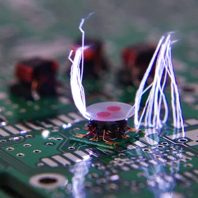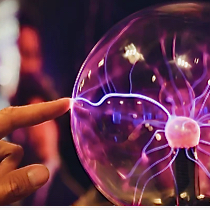
- Type of materials: Static buildup needs two dissimilar materials in contact. The conductive properties of the materials are fundamental.
- Presence of impurities: This includes dust and unexpected ions.
- Interfacial surface between the objects: A large contact area facilitates the migration of electrons between the materials.
- Speed of separation: The higher the speed of separation, the lesser the chance for the electrons to go back to the parent body – and the higher the charge buildup.
- Velocity: The motion between the surfaces helps the charge build up, increasing the surface under contact by enhancing the ability of the irregularities on both surfaces to touch, and the heat produced by friction facilitates electron relocation. Static charges are usual in fast production lines with intense contact.
- Humidity: Increases the charge leakage through the air surrounding the charged object, reducing the buildup. Hazards of Static Electricity
Static Electricity
Static buildup can be found just about anywhere friction occurs.
- Gears and belts: V belts, mostly flat power transmission lines, are particularly susceptible to static charge buildup due to the friction between belt and pulley. Rubber conveyor belts employed in material-handling systems do not cause appreciable charge buildup due to their low linear speed.
- Pouring powders: Pouring pulverized non-conducting solid particles down chutes or troughs.
- Dust transport: Pneumatic transport of powders and solids.
- Jet nozzles: Air, gases, liquids expelled from jets, or processes such as sandblasting and shotcreting (sprayed concrete).
- Metal tanks: When resting on a non-conductive base, such as a tank truck on rubber tires, mostly when filled through the dome.
- Metal tanks with a non-conductive liner.
- Tanks or vessels made of non-conductive material.
- Liquid falling into a tank during filling operations.
- Non-conductive piping, such as fiberglass or PVC, can build up static charges outside due to liquid flow.
- Isolated sections of metallic piping, such as sections separated by gasketed flanged joints or swing joints.
- Rubber wheels on furniture in motion over non-conducting flooring, and automobile tires on the road.
- People’s bodies due to the friction of rubber shoes.
- Charges generated on fabrics. Hazards of Static Electricity
Risks of Static
Some dangers posed by static electricity are:
- Electric shock due to the flow of current through the body, causing a person everything from an uncomfortable zap to falls, burns, or stopping the heart.
- Fires or explosions due to the ignition of flammable or explosive mixtures.
- Production disturbances in the processing of paper, plastics, composites, powder, granules, and liquids.
- Damage to electronic equipment and components from electrostatic discharge (ESD).
- Damage to mechanical components such as bearings due to sparking through the oil films on bearing surfaces. Hazards of Static Electricity
It is vital to analyse the static buildup potential of facilities and establish protective procedures.
Spark Discharge
Sparks are responsible for most industrial fires and explosions as a result of static electricity. And a spark is a discharge of static electricity between two conductors. Also, you may have felt or seen a spark jumping from a key or finger to a metallic grounded object after walking across the carpet. Spark discharges occur when the charges accumulated on conductive objects create an electric field that exceeds the ambient atmosphere’s electric strength.
The energy liberated in a static electricity discharge varies over a broad range. The energy transfer in a spark discharge may reach values up to 10,000 mJ. A value of 0.2 mJ may pose an ignition hazard, although this low spark energy is frequently below the threshold of human auditory and visual perception. And the amount of charge that an object accumulates depends on its storage capacity. Also, a conductive item is incapable of retaining a significant amount of electrostatic charge when it is grounded.
The voltage designates the charge strength. A human body can reach 10,000 V or more in a dry environment and a few hundred volts in a wet environment. And other discharges, with the type of discharge being influenced by the characteristics of the materials involved – brush discharge, propagating brush discharge, cone discharge, and corona discharge. These discharges have different energy transfer capabilities and ignitability properties.
Grounding to Avoid Sparks
One effective way of preventing sparks is by connecting all objects to a conductor (bonding) and to the earth (grounding). Bonding is a secure joining of metallic parts that form an electrically conductive path, dropping their voltage difference to near zero. Yet, there may be a voltage difference relative to the ground or another object. Bonding prevents sparks from jumping between two things that are at the same potential.
Grounding is a connection between the objects and the earth, allowing the discharge of electrostatic electricity to the ground. In addition to facilities, people sometimes need to be grounded. Personnel grounding employs specialized flooring and grounding fabrications worn on the wrists or over the shoes. Hazards of Static Electricity
Applications of Electrostatics
Although dangerous and necessary to avoid in many situations, static electricity has many practical applications. Some examples are:
- Electrostatic precipitators remove the smoke from waste gases before they pass out of the chimneys in power stations that burn fossil fuels. In a home HVAC system, precipitators remove polluting particles, allergens, and irritants.
- Inkjet photocopiers and printers use static electricity to guide a minute jet of ink to the page’s precise position.
- Laser printers and photocopiers using the xerographic process.
- The Van de Graaff – electrostatic – generator is applied in nuclear physics research.
Hazards of Static Electricity
Some characteristics that increase the generation of electrostatics are low material conductivity, impurities, large contact surface, high speed of separation, high velocity, and low air humidity.
Electrostatic sparks may have enough energy to produce electric shocks, cause electronic damage, spoil mechanical components, disrupt production processes, and generate fires and explosions. But static electricity has practical applications like electrostatic precipitators, photocopiers, printers, and Van de Graaff generators. Bonding and grounding are easy, effective, and cheap methods to prevent electrostatic discharges. Hazards of Static Electricity
Author: Lorenzo Mari
Please share with friends and colleagues if you enjoyed reading ‘Hazards of Static Electricity′. – thank you
Perkune audiophile cables 2023 I Professional audio


